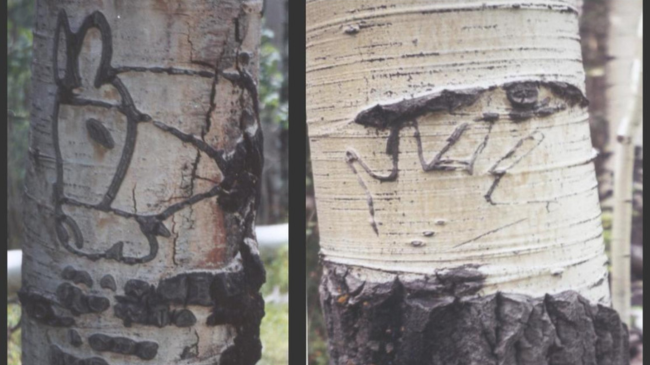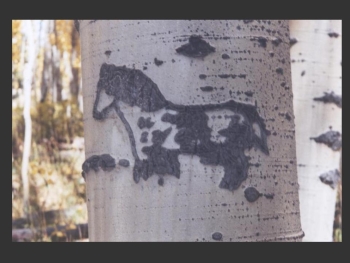
- This event has passed.
“Written in Bark” – Aspens and Arborglyphs Hike
September 25 @ 9:00 am - 1:00 pm

Names, dates, and drawings etched into the soft, white bark of Aspen trees stand silent witness to travelers from ages past. Carved by lonely sheepherders, cowboys, and sometimes other anonymous wayfarers, these amateur signposts are more than just antique graffiti, with many of them bound in the history and traditions of a bygone era. Local Arborglyph enthusiast/presenter Peggy Bergon leads hikers into the Buckles Lake area south of Pagosa Springs in search of these fascinating artworks on living wooden canvas.
The hike is approximately 3 miles long, with an easy-moderate difficulty level and minor elevation gains. The hike will include some off-trail portions.
When: September 25, 2025 from 9am – 1pm
Where: Buckles Lake Trailhead; Take US-84E south of Pagosa. Turn left onto to Forest Road 663. Follow for about 7 miles
What to Bring:
- Hiking boots,
- appropriate apparel for mountain weather, and
- your love of local history.
Additional Details:
- Adults only
- No dogs please
- Parking and restrooms are available at the trailhead
Questions? Contact SJMA’s Pagosa Education Specialist, Brooks at bletchworth@sjma.org
Registration is full. Spaces limited to 15 attendees.
Background on Arborglyphs:
 Before the days of large cattle ranches dominating the western landscape, pioneering Hispanic families were raising thousands of sheep throughout the region. Woolies, as they were called, were introduced by the Conquistadors in the 1500’s and mutton would quickly become the cornerstone of the early western economy.
Before the days of large cattle ranches dominating the western landscape, pioneering Hispanic families were raising thousands of sheep throughout the region. Woolies, as they were called, were introduced by the Conquistadors in the 1500’s and mutton would quickly become the cornerstone of the early western economy.
By the late 1800’s, local families like the Archuleta’s and the Martinez’s were prominent sheep ranchers with flocks ranging from 20,000 to 100,000 animals. Caring for the animals was entrusted to a sheepherder, with most flocks consisting of approximately 1,500 animals. Each spring, sheepherders embarked on an epic journey to guide the sheep from winter pastures in New Mexico to the lush alpine meadows of Colorado.
With time on his hands, the smooth white bark of the aspen tree provided the perfect slate for the herder to give form to his thoughts. The carvings they left are called arborglyphs, a term that means “tree-writing.” The arborglyphs are a tangible yet rapidly disappearing gallery of unique folk art. Many carvings are over 100 years old and are being lost due to the disappearance of the aging aspen forests. Soon, visitors enjoying the surrounding forests will no longer see these reminders of the past. We strive to capture and honor this huge contribution to the cultural enrichment of the area, while highlighting the importance of these men to the early economy of the west.
